Marketing Methodology Report: Chapter 3 Analysis for University Course
VerifiedAdded on 2022/10/11
|15
|3454
|7
Report
AI Summary
This report presents a detailed analysis of the marketing methodology employed in a research study. It begins by outlining the research philosophy, specifically interpretivism, and its relevance to understanding consumer behavior, particularly among millennials in the context of mobile shopping within the fashion industry. The report then delves into the chosen research methods, emphasizing the use of qualitative research to gather in-depth insights. It discusses the importance of primary and secondary data, the design of interview guides, and the selection of a non-probability sampling approach, specifically judgment sampling. The report covers data collection processes, including interviews, and the subsequent data analysis techniques. It highlights the ethical considerations and potential limitations of the research. The methodology chapter provides a comprehensive overview of the research design, ensuring the study's ability to meet its objectives and answer the research questions.
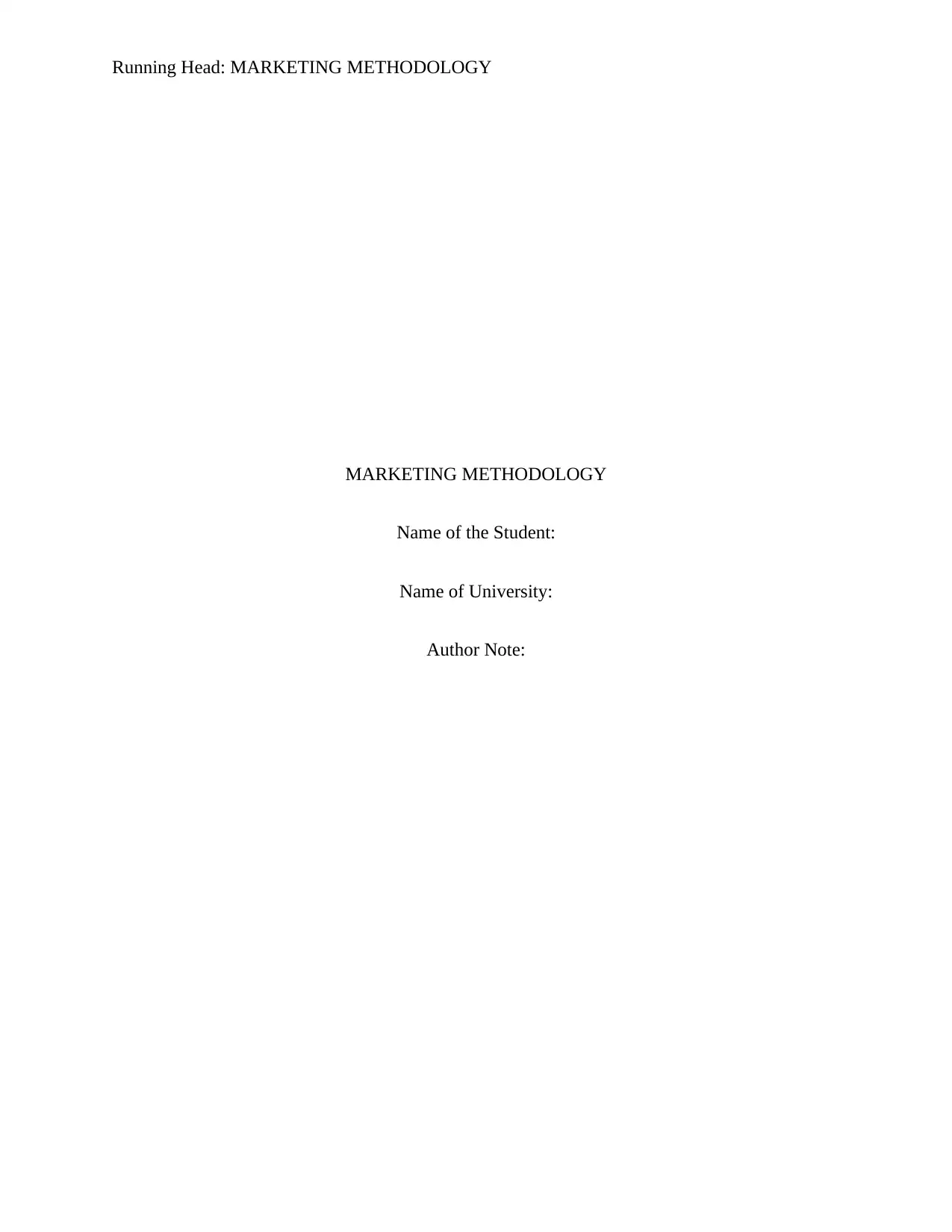
Running Head: MARKETING METHODOLOGY
MARKETING METHODOLOGY
Name of the Student:
Name of University:
Author Note:
MARKETING METHODOLOGY
Name of the Student:
Name of University:
Author Note:
Paraphrase This Document
Need a fresh take? Get an instant paraphrase of this document with our AI Paraphraser
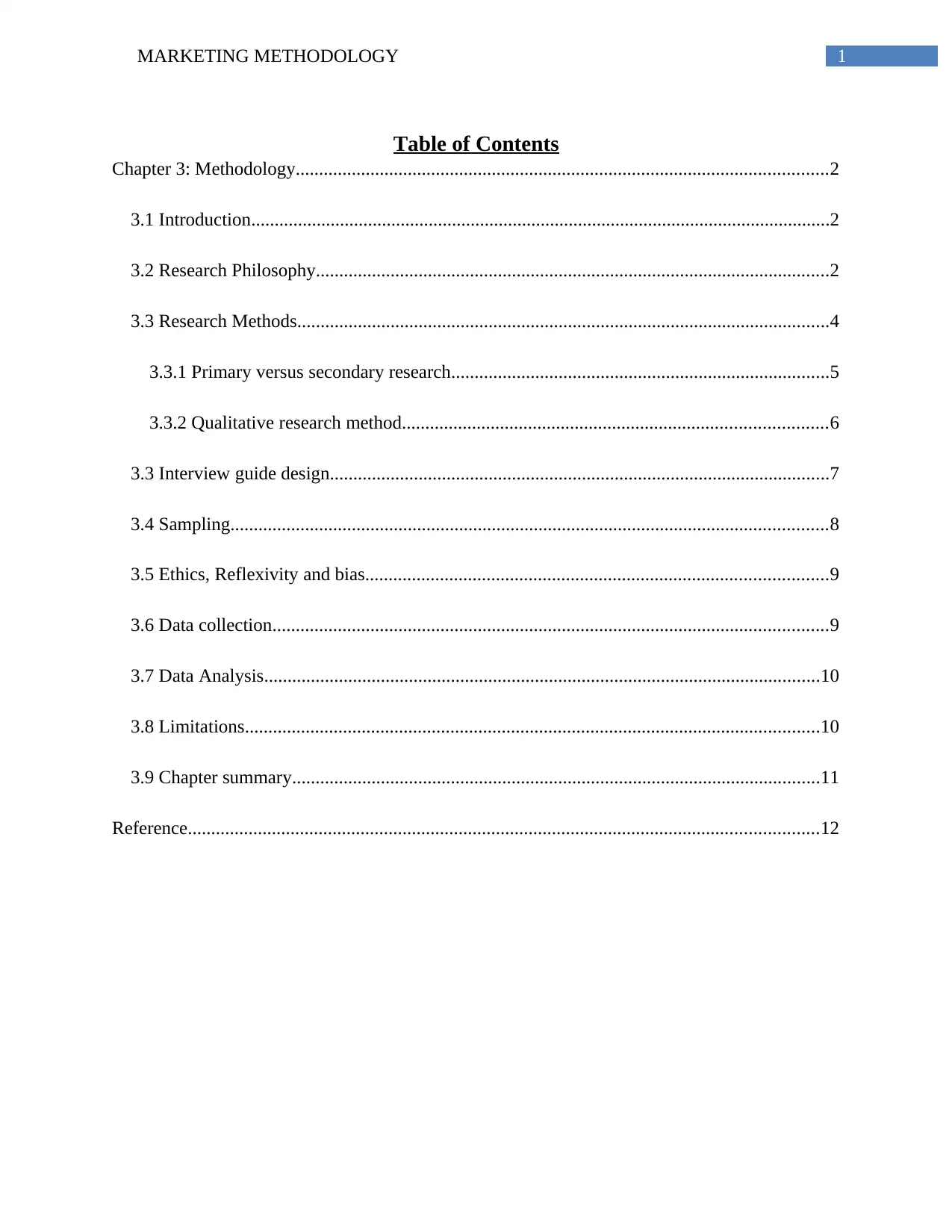
1MARKETING METHODOLOGY
Table of Contents
Chapter 3: Methodology..................................................................................................................2
3.1 Introduction............................................................................................................................2
3.2 Research Philosophy..............................................................................................................2
3.3 Research Methods..................................................................................................................4
3.3.1 Primary versus secondary research.................................................................................5
3.3.2 Qualitative research method...........................................................................................6
3.3 Interview guide design...........................................................................................................7
3.4 Sampling................................................................................................................................8
3.5 Ethics, Reflexivity and bias...................................................................................................9
3.6 Data collection.......................................................................................................................9
3.7 Data Analysis.......................................................................................................................10
3.8 Limitations...........................................................................................................................10
3.9 Chapter summary.................................................................................................................11
Reference.......................................................................................................................................12
Table of Contents
Chapter 3: Methodology..................................................................................................................2
3.1 Introduction............................................................................................................................2
3.2 Research Philosophy..............................................................................................................2
3.3 Research Methods..................................................................................................................4
3.3.1 Primary versus secondary research.................................................................................5
3.3.2 Qualitative research method...........................................................................................6
3.3 Interview guide design...........................................................................................................7
3.4 Sampling................................................................................................................................8
3.5 Ethics, Reflexivity and bias...................................................................................................9
3.6 Data collection.......................................................................................................................9
3.7 Data Analysis.......................................................................................................................10
3.8 Limitations...........................................................................................................................10
3.9 Chapter summary.................................................................................................................11
Reference.......................................................................................................................................12

2MARKETING METHODOLOGY
Chapter 3: Methodology
3.1 Introduction
This research is going to analyse the research instrument, sampling method, data collection
process and the evaluating those factors in order to bring the research findings relevant with the
research aims. In this regard, the purpose of this methodology chapter is to provide an outline of
the required research process with proper justification so that the research will achieve expected
outcome properly.
3.2 Research Philosophy
Research philosophy is associated with the beliefs and assumption regarding the knowledge and
deals with the source, nature and the development of knowledge. In other words, it can be stated
that, research philosophy tries to underline the required data collection method and the way those
data will be analysed and used. It is important to know that the role of research philosophy is to
assume the methods of the research and shape the philosophy accordingly (Padilla-Díaz 2015).
Henceforth, a well thought process and consistent set of assumptions are the basic approaches
that a research philosophy possesses. It is further associated with the choice of methods, research
strategy, data collection techniques and the process of evaluation. From this basic understanding,
it can be stated that the role of the research philosophy is to develop a strong belief and
assumption of the researcher in course of establishing a set of methodological practices. From
figure 3.1 it can be found that the research philosophy is located at the outer layer of the research
onion and as a result of that it is considered to be the first subject to discuss. Saunders et al.
(2015) advocated that the research philosophy is comprised with five major types pragmatism,
critical realism, interpretivism, post modernism and positivism.
Chapter 3: Methodology
3.1 Introduction
This research is going to analyse the research instrument, sampling method, data collection
process and the evaluating those factors in order to bring the research findings relevant with the
research aims. In this regard, the purpose of this methodology chapter is to provide an outline of
the required research process with proper justification so that the research will achieve expected
outcome properly.
3.2 Research Philosophy
Research philosophy is associated with the beliefs and assumption regarding the knowledge and
deals with the source, nature and the development of knowledge. In other words, it can be stated
that, research philosophy tries to underline the required data collection method and the way those
data will be analysed and used. It is important to know that the role of research philosophy is to
assume the methods of the research and shape the philosophy accordingly (Padilla-Díaz 2015).
Henceforth, a well thought process and consistent set of assumptions are the basic approaches
that a research philosophy possesses. It is further associated with the choice of methods, research
strategy, data collection techniques and the process of evaluation. From this basic understanding,
it can be stated that the role of the research philosophy is to develop a strong belief and
assumption of the researcher in course of establishing a set of methodological practices. From
figure 3.1 it can be found that the research philosophy is located at the outer layer of the research
onion and as a result of that it is considered to be the first subject to discuss. Saunders et al.
(2015) advocated that the research philosophy is comprised with five major types pragmatism,
critical realism, interpretivism, post modernism and positivism.
⊘ This is a preview!⊘
Do you want full access?
Subscribe today to unlock all pages.

Trusted by 1+ million students worldwide
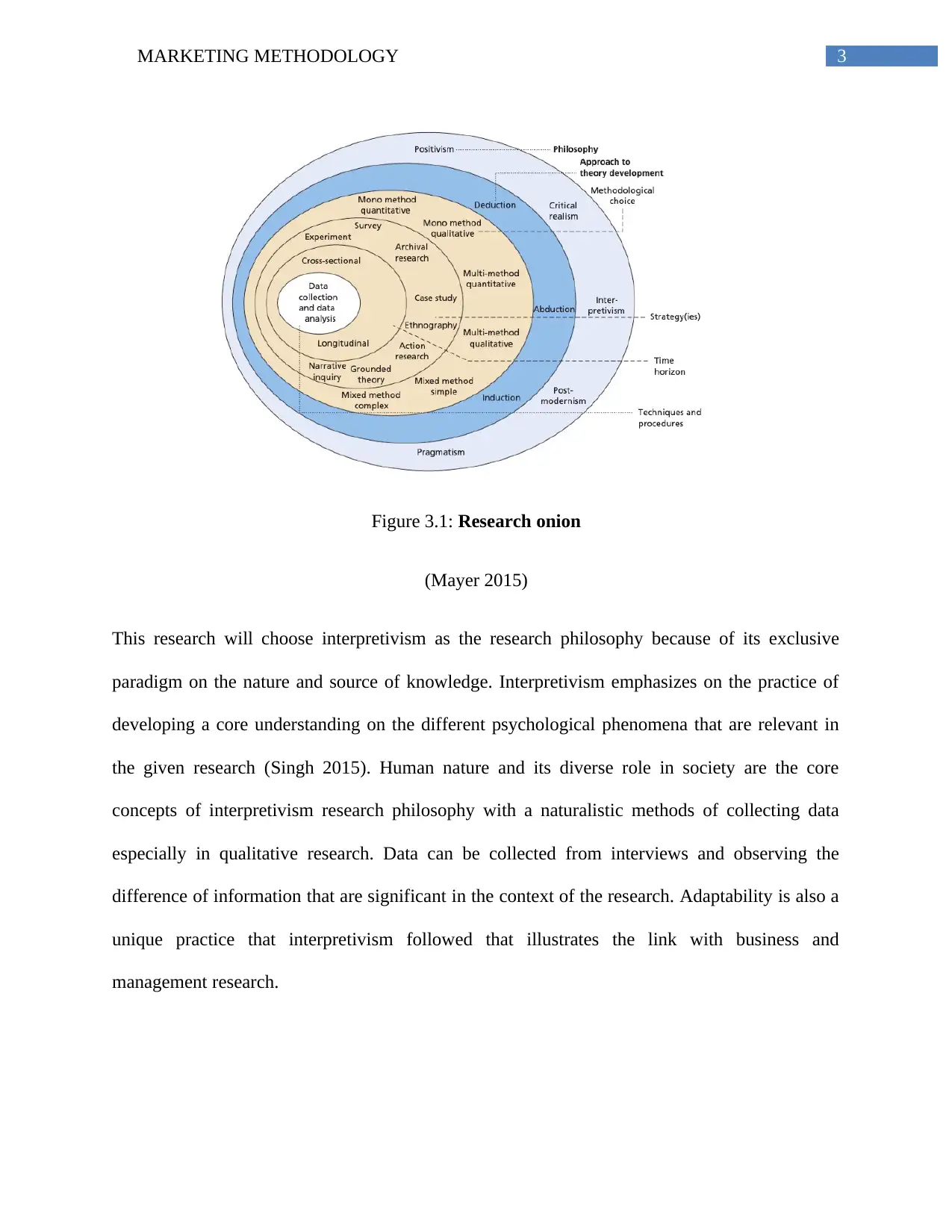
3MARKETING METHODOLOGY
Figure 3.1: Research onion
(Mayer 2015)
This research will choose interpretivism as the research philosophy because of its exclusive
paradigm on the nature and source of knowledge. Interpretivism emphasizes on the practice of
developing a core understanding on the different psychological phenomena that are relevant in
the given research (Singh 2015). Human nature and its diverse role in society are the core
concepts of interpretivism research philosophy with a naturalistic methods of collecting data
especially in qualitative research. Data can be collected from interviews and observing the
difference of information that are significant in the context of the research. Adaptability is also a
unique practice that interpretivism followed that illustrates the link with business and
management research.
Figure 3.1: Research onion
(Mayer 2015)
This research will choose interpretivism as the research philosophy because of its exclusive
paradigm on the nature and source of knowledge. Interpretivism emphasizes on the practice of
developing a core understanding on the different psychological phenomena that are relevant in
the given research (Singh 2015). Human nature and its diverse role in society are the core
concepts of interpretivism research philosophy with a naturalistic methods of collecting data
especially in qualitative research. Data can be collected from interviews and observing the
difference of information that are significant in the context of the research. Adaptability is also a
unique practice that interpretivism followed that illustrates the link with business and
management research.
Paraphrase This Document
Need a fresh take? Get an instant paraphrase of this document with our AI Paraphraser
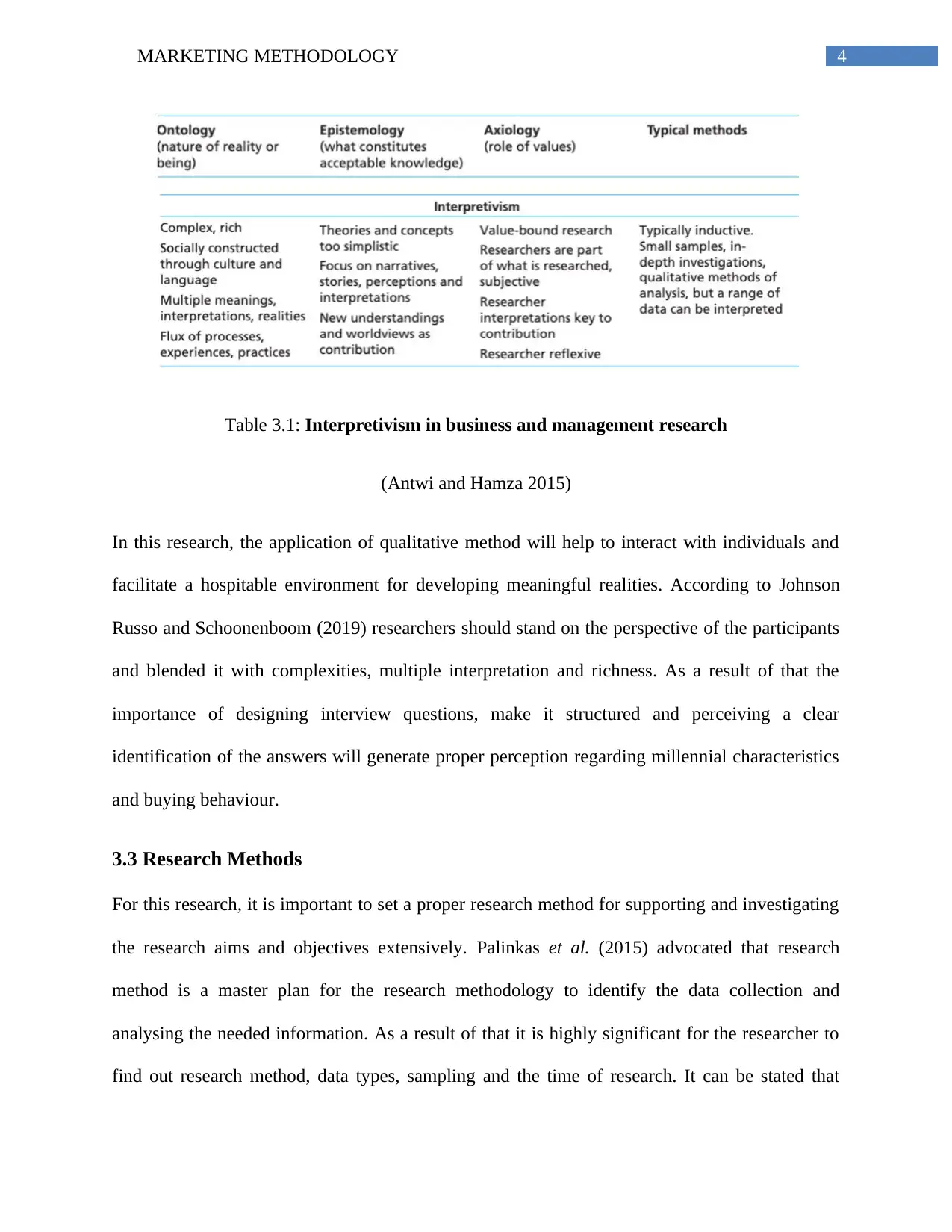
4MARKETING METHODOLOGY
Table 3.1: Interpretivism in business and management research
(Antwi and Hamza 2015)
In this research, the application of qualitative method will help to interact with individuals and
facilitate a hospitable environment for developing meaningful realities. According to Johnson
Russo and Schoonenboom (2019) researchers should stand on the perspective of the participants
and blended it with complexities, multiple interpretation and richness. As a result of that the
importance of designing interview questions, make it structured and perceiving a clear
identification of the answers will generate proper perception regarding millennial characteristics
and buying behaviour.
3.3 Research Methods
For this research, it is important to set a proper research method for supporting and investigating
the research aims and objectives extensively. Palinkas et al. (2015) advocated that research
method is a master plan for the research methodology to identify the data collection and
analysing the needed information. As a result of that it is highly significant for the researcher to
find out research method, data types, sampling and the time of research. It can be stated that
Table 3.1: Interpretivism in business and management research
(Antwi and Hamza 2015)
In this research, the application of qualitative method will help to interact with individuals and
facilitate a hospitable environment for developing meaningful realities. According to Johnson
Russo and Schoonenboom (2019) researchers should stand on the perspective of the participants
and blended it with complexities, multiple interpretation and richness. As a result of that the
importance of designing interview questions, make it structured and perceiving a clear
identification of the answers will generate proper perception regarding millennial characteristics
and buying behaviour.
3.3 Research Methods
For this research, it is important to set a proper research method for supporting and investigating
the research aims and objectives extensively. Palinkas et al. (2015) advocated that research
method is a master plan for the research methodology to identify the data collection and
analysing the needed information. As a result of that it is highly significant for the researcher to
find out research method, data types, sampling and the time of research. It can be stated that

5MARKETING METHODOLOGY
exploratory research is a conclusive research that incorporates descriptive and casual research
theme which is appropriate for the marketing research.
It is important to know that the role of the research practice is to facilitate a core understanding
of the exploratory research method in case of getting less perception regarding the research
concept and scope of the research topic. Moreover, it is often found out that the research is
unfamiliar with the internal connection of research objectives and as a result of that the theories
and practices used by the research fail to get the expected outcome and nullified. Van Dun et al.
(2017) opined that the way of exploratory research practice is resembled with the secondary
research data or the expert can interview the respondents. In association with this, case study
analysis and the in-depth interview session are also pertinent in course of successfully reach to a
conclusion.
In response to this, the exploratory research will point out to the theme of the research that is the
millennial customers’ purchasing behaviour on mobile shopping and the buying behaviour in
fashion industry through the use of mobile shopping.
3.3.1 Primary versus secondary research
The role of the research method is to find out the right approach of collecting all relevant
information from various resources and analyse the result of the research question and
hypothesis testing (Palinkas et al. 2015). There are two types of data that a data collection
process is followed in terms of the primary data and the secondary data. As far as the research of
Ness (2015) is concerned, it can be stated that the role of primary data is to collect the
information directly from the respondents. There are certainly a number of tools and processes
that are responsible in order to collect the data properly such as observation, quantitative
exploratory research is a conclusive research that incorporates descriptive and casual research
theme which is appropriate for the marketing research.
It is important to know that the role of the research practice is to facilitate a core understanding
of the exploratory research method in case of getting less perception regarding the research
concept and scope of the research topic. Moreover, it is often found out that the research is
unfamiliar with the internal connection of research objectives and as a result of that the theories
and practices used by the research fail to get the expected outcome and nullified. Van Dun et al.
(2017) opined that the way of exploratory research practice is resembled with the secondary
research data or the expert can interview the respondents. In association with this, case study
analysis and the in-depth interview session are also pertinent in course of successfully reach to a
conclusion.
In response to this, the exploratory research will point out to the theme of the research that is the
millennial customers’ purchasing behaviour on mobile shopping and the buying behaviour in
fashion industry through the use of mobile shopping.
3.3.1 Primary versus secondary research
The role of the research method is to find out the right approach of collecting all relevant
information from various resources and analyse the result of the research question and
hypothesis testing (Palinkas et al. 2015). There are two types of data that a data collection
process is followed in terms of the primary data and the secondary data. As far as the research of
Ness (2015) is concerned, it can be stated that the role of primary data is to collect the
information directly from the respondents. There are certainly a number of tools and processes
that are responsible in order to collect the data properly such as observation, quantitative
⊘ This is a preview!⊘
Do you want full access?
Subscribe today to unlock all pages.

Trusted by 1+ million students worldwide
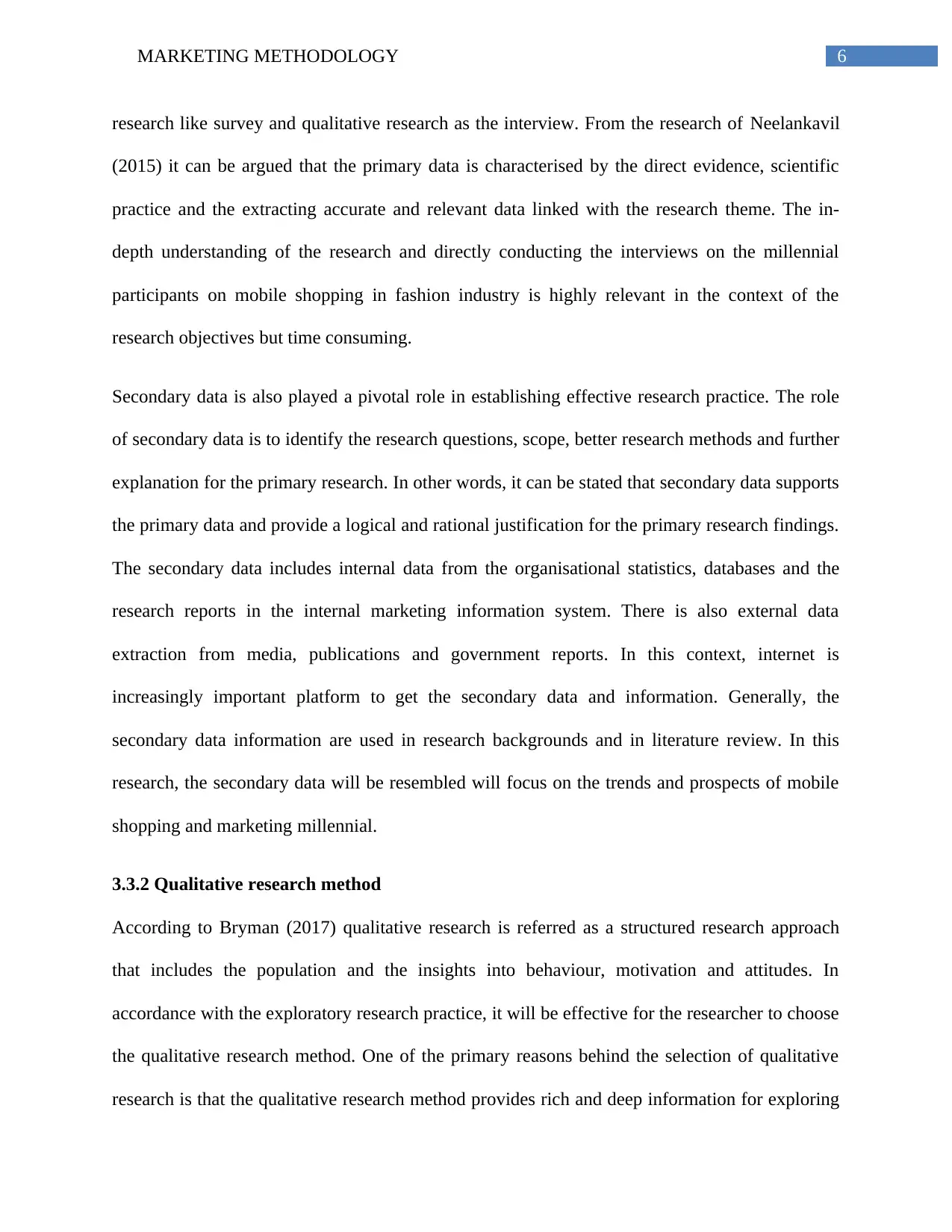
6MARKETING METHODOLOGY
research like survey and qualitative research as the interview. From the research of Neelankavil
(2015) it can be argued that the primary data is characterised by the direct evidence, scientific
practice and the extracting accurate and relevant data linked with the research theme. The in-
depth understanding of the research and directly conducting the interviews on the millennial
participants on mobile shopping in fashion industry is highly relevant in the context of the
research objectives but time consuming.
Secondary data is also played a pivotal role in establishing effective research practice. The role
of secondary data is to identify the research questions, scope, better research methods and further
explanation for the primary research. In other words, it can be stated that secondary data supports
the primary data and provide a logical and rational justification for the primary research findings.
The secondary data includes internal data from the organisational statistics, databases and the
research reports in the internal marketing information system. There is also external data
extraction from media, publications and government reports. In this context, internet is
increasingly important platform to get the secondary data and information. Generally, the
secondary data information are used in research backgrounds and in literature review. In this
research, the secondary data will be resembled will focus on the trends and prospects of mobile
shopping and marketing millennial.
3.3.2 Qualitative research method
According to Bryman (2017) qualitative research is referred as a structured research approach
that includes the population and the insights into behaviour, motivation and attitudes. In
accordance with the exploratory research practice, it will be effective for the researcher to choose
the qualitative research method. One of the primary reasons behind the selection of qualitative
research is that the qualitative research method provides rich and deep information for exploring
research like survey and qualitative research as the interview. From the research of Neelankavil
(2015) it can be argued that the primary data is characterised by the direct evidence, scientific
practice and the extracting accurate and relevant data linked with the research theme. The in-
depth understanding of the research and directly conducting the interviews on the millennial
participants on mobile shopping in fashion industry is highly relevant in the context of the
research objectives but time consuming.
Secondary data is also played a pivotal role in establishing effective research practice. The role
of secondary data is to identify the research questions, scope, better research methods and further
explanation for the primary research. In other words, it can be stated that secondary data supports
the primary data and provide a logical and rational justification for the primary research findings.
The secondary data includes internal data from the organisational statistics, databases and the
research reports in the internal marketing information system. There is also external data
extraction from media, publications and government reports. In this context, internet is
increasingly important platform to get the secondary data and information. Generally, the
secondary data information are used in research backgrounds and in literature review. In this
research, the secondary data will be resembled will focus on the trends and prospects of mobile
shopping and marketing millennial.
3.3.2 Qualitative research method
According to Bryman (2017) qualitative research is referred as a structured research approach
that includes the population and the insights into behaviour, motivation and attitudes. In
accordance with the exploratory research practice, it will be effective for the researcher to choose
the qualitative research method. One of the primary reasons behind the selection of qualitative
research is that the qualitative research method provides rich and deep information for exploring
Paraphrase This Document
Need a fresh take? Get an instant paraphrase of this document with our AI Paraphraser

7MARKETING METHODOLOGY
ideas and enabling researchers to understand the problem and identify the impact of the research
process (Leung 2015). Qualitative research has been increased extensively in the marketing
researches and identify the customer attitudes towards products or processes because the
customers’ point of view is highly relevant in order to understand the efficacy of the marketing
practices. For this research, it is highly relevant for the researcher to explore the millennial
customers and their behavioural characteristics in buying fashion products through mobile
shopping. As a matter of fact, the research also cares to investigate the relationship between
characteristics and buying behaviour. Therefore, qualitative research will highly supports this
research than the quantitative approach.
In this context, it is also important for the organisation to measure a suitable sample size for a
better research outcome. The individual interview is also significant in this regard to facilitate a
good sample size for the researcher. Nevertheless, setting the interview questionnaire and fixing
the sample size are pertinent for the researchers. Firstly, it is important to make the data
collection more flexible and semi-structured so that the researcher can change the questions
based on the answers of the interviewees. After that a small number of sample size will be easier
and convenient for the research to evaluate the data in short period of time. In association to this,
a penetrating insight is also important for the research that includes rich, deep and insightful data
(McCusker and Gunaydin 2015). The professional backgrounds of the participants will not be
disclosed. Limited time and more specific idea of mobile shopping could be other reason for
using individual interview. Therefore, a thematic analysis can be used to explain this part.
3.3 Interview guide design
It is essential for the researcher to put focus on the interview guide as it is essential for the
research to consider the broader agenda of topics, non-directive questions and the techniques that
ideas and enabling researchers to understand the problem and identify the impact of the research
process (Leung 2015). Qualitative research has been increased extensively in the marketing
researches and identify the customer attitudes towards products or processes because the
customers’ point of view is highly relevant in order to understand the efficacy of the marketing
practices. For this research, it is highly relevant for the researcher to explore the millennial
customers and their behavioural characteristics in buying fashion products through mobile
shopping. As a matter of fact, the research also cares to investigate the relationship between
characteristics and buying behaviour. Therefore, qualitative research will highly supports this
research than the quantitative approach.
In this context, it is also important for the organisation to measure a suitable sample size for a
better research outcome. The individual interview is also significant in this regard to facilitate a
good sample size for the researcher. Nevertheless, setting the interview questionnaire and fixing
the sample size are pertinent for the researchers. Firstly, it is important to make the data
collection more flexible and semi-structured so that the researcher can change the questions
based on the answers of the interviewees. After that a small number of sample size will be easier
and convenient for the research to evaluate the data in short period of time. In association to this,
a penetrating insight is also important for the research that includes rich, deep and insightful data
(McCusker and Gunaydin 2015). The professional backgrounds of the participants will not be
disclosed. Limited time and more specific idea of mobile shopping could be other reason for
using individual interview. Therefore, a thematic analysis can be used to explain this part.
3.3 Interview guide design
It is essential for the researcher to put focus on the interview guide as it is essential for the
research to consider the broader agenda of topics, non-directive questions and the techniques that
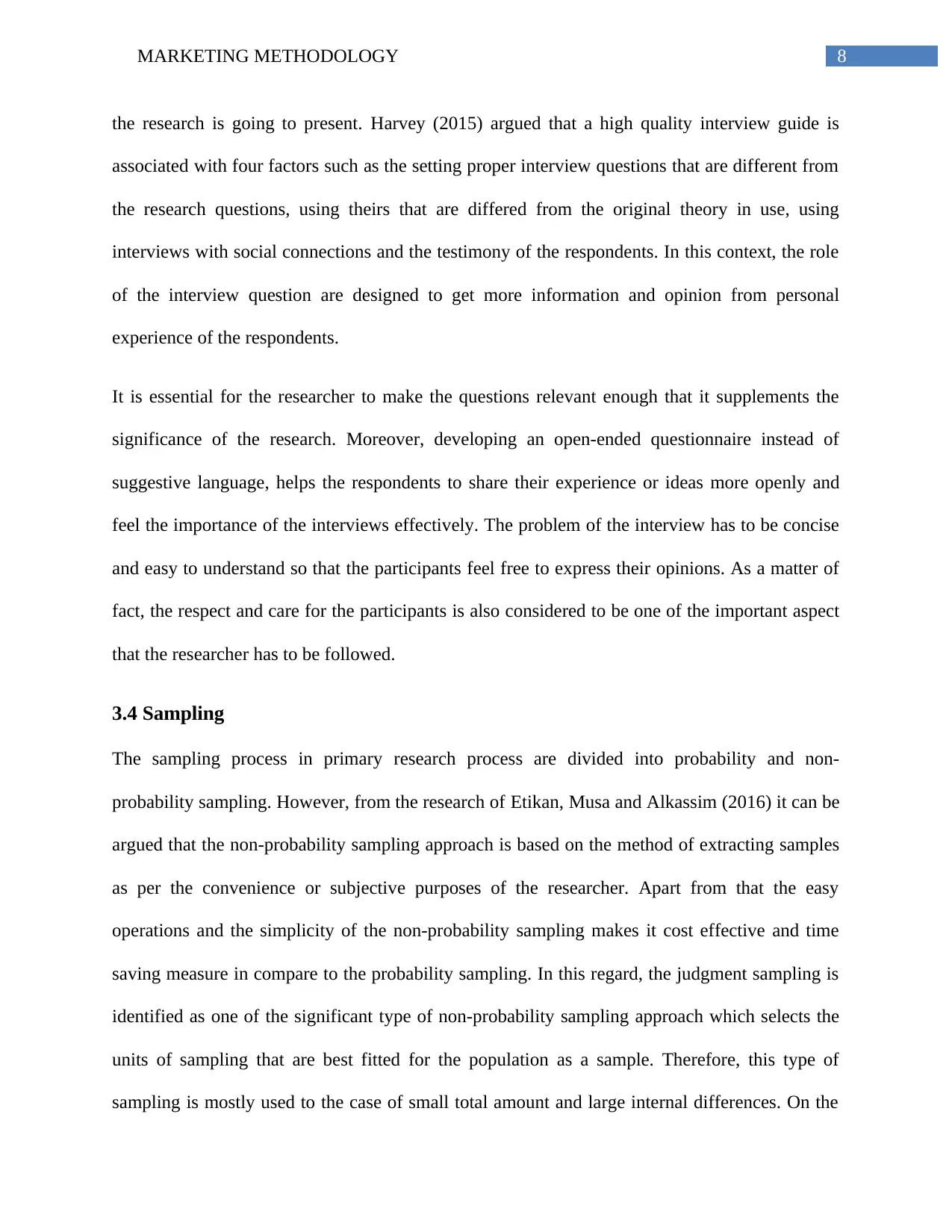
8MARKETING METHODOLOGY
the research is going to present. Harvey (2015) argued that a high quality interview guide is
associated with four factors such as the setting proper interview questions that are different from
the research questions, using theirs that are differed from the original theory in use, using
interviews with social connections and the testimony of the respondents. In this context, the role
of the interview question are designed to get more information and opinion from personal
experience of the respondents.
It is essential for the researcher to make the questions relevant enough that it supplements the
significance of the research. Moreover, developing an open-ended questionnaire instead of
suggestive language, helps the respondents to share their experience or ideas more openly and
feel the importance of the interviews effectively. The problem of the interview has to be concise
and easy to understand so that the participants feel free to express their opinions. As a matter of
fact, the respect and care for the participants is also considered to be one of the important aspect
that the researcher has to be followed.
3.4 Sampling
The sampling process in primary research process are divided into probability and non-
probability sampling. However, from the research of Etikan, Musa and Alkassim (2016) it can be
argued that the non-probability sampling approach is based on the method of extracting samples
as per the convenience or subjective purposes of the researcher. Apart from that the easy
operations and the simplicity of the non-probability sampling makes it cost effective and time
saving measure in compare to the probability sampling. In this regard, the judgment sampling is
identified as one of the significant type of non-probability sampling approach which selects the
units of sampling that are best fitted for the population as a sample. Therefore, this type of
sampling is mostly used to the case of small total amount and large internal differences. On the
the research is going to present. Harvey (2015) argued that a high quality interview guide is
associated with four factors such as the setting proper interview questions that are different from
the research questions, using theirs that are differed from the original theory in use, using
interviews with social connections and the testimony of the respondents. In this context, the role
of the interview question are designed to get more information and opinion from personal
experience of the respondents.
It is essential for the researcher to make the questions relevant enough that it supplements the
significance of the research. Moreover, developing an open-ended questionnaire instead of
suggestive language, helps the respondents to share their experience or ideas more openly and
feel the importance of the interviews effectively. The problem of the interview has to be concise
and easy to understand so that the participants feel free to express their opinions. As a matter of
fact, the respect and care for the participants is also considered to be one of the important aspect
that the researcher has to be followed.
3.4 Sampling
The sampling process in primary research process are divided into probability and non-
probability sampling. However, from the research of Etikan, Musa and Alkassim (2016) it can be
argued that the non-probability sampling approach is based on the method of extracting samples
as per the convenience or subjective purposes of the researcher. Apart from that the easy
operations and the simplicity of the non-probability sampling makes it cost effective and time
saving measure in compare to the probability sampling. In this regard, the judgment sampling is
identified as one of the significant type of non-probability sampling approach which selects the
units of sampling that are best fitted for the population as a sample. Therefore, this type of
sampling is mostly used to the case of small total amount and large internal differences. On the
⊘ This is a preview!⊘
Do you want full access?
Subscribe today to unlock all pages.

Trusted by 1+ million students worldwide
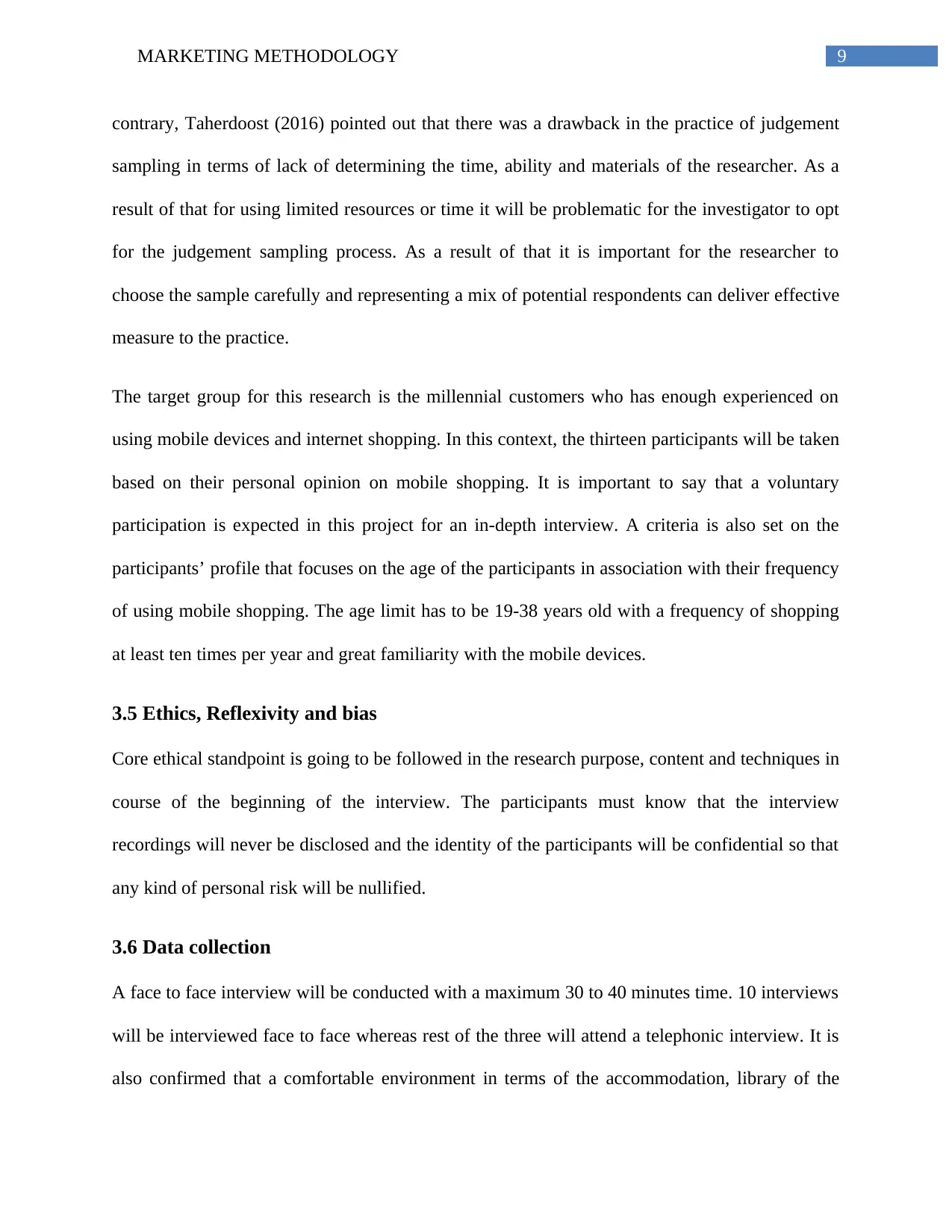
9MARKETING METHODOLOGY
contrary, Taherdoost (2016) pointed out that there was a drawback in the practice of judgement
sampling in terms of lack of determining the time, ability and materials of the researcher. As a
result of that for using limited resources or time it will be problematic for the investigator to opt
for the judgement sampling process. As a result of that it is important for the researcher to
choose the sample carefully and representing a mix of potential respondents can deliver effective
measure to the practice.
The target group for this research is the millennial customers who has enough experienced on
using mobile devices and internet shopping. In this context, the thirteen participants will be taken
based on their personal opinion on mobile shopping. It is important to say that a voluntary
participation is expected in this project for an in-depth interview. A criteria is also set on the
participants’ profile that focuses on the age of the participants in association with their frequency
of using mobile shopping. The age limit has to be 19-38 years old with a frequency of shopping
at least ten times per year and great familiarity with the mobile devices.
3.5 Ethics, Reflexivity and bias
Core ethical standpoint is going to be followed in the research purpose, content and techniques in
course of the beginning of the interview. The participants must know that the interview
recordings will never be disclosed and the identity of the participants will be confidential so that
any kind of personal risk will be nullified.
3.6 Data collection
A face to face interview will be conducted with a maximum 30 to 40 minutes time. 10 interviews
will be interviewed face to face whereas rest of the three will attend a telephonic interview. It is
also confirmed that a comfortable environment in terms of the accommodation, library of the
contrary, Taherdoost (2016) pointed out that there was a drawback in the practice of judgement
sampling in terms of lack of determining the time, ability and materials of the researcher. As a
result of that for using limited resources or time it will be problematic for the investigator to opt
for the judgement sampling process. As a result of that it is important for the researcher to
choose the sample carefully and representing a mix of potential respondents can deliver effective
measure to the practice.
The target group for this research is the millennial customers who has enough experienced on
using mobile devices and internet shopping. In this context, the thirteen participants will be taken
based on their personal opinion on mobile shopping. It is important to say that a voluntary
participation is expected in this project for an in-depth interview. A criteria is also set on the
participants’ profile that focuses on the age of the participants in association with their frequency
of using mobile shopping. The age limit has to be 19-38 years old with a frequency of shopping
at least ten times per year and great familiarity with the mobile devices.
3.5 Ethics, Reflexivity and bias
Core ethical standpoint is going to be followed in the research purpose, content and techniques in
course of the beginning of the interview. The participants must know that the interview
recordings will never be disclosed and the identity of the participants will be confidential so that
any kind of personal risk will be nullified.
3.6 Data collection
A face to face interview will be conducted with a maximum 30 to 40 minutes time. 10 interviews
will be interviewed face to face whereas rest of the three will attend a telephonic interview. It is
also confirmed that a comfortable environment in terms of the accommodation, library of the
Paraphrase This Document
Need a fresh take? Get an instant paraphrase of this document with our AI Paraphraser
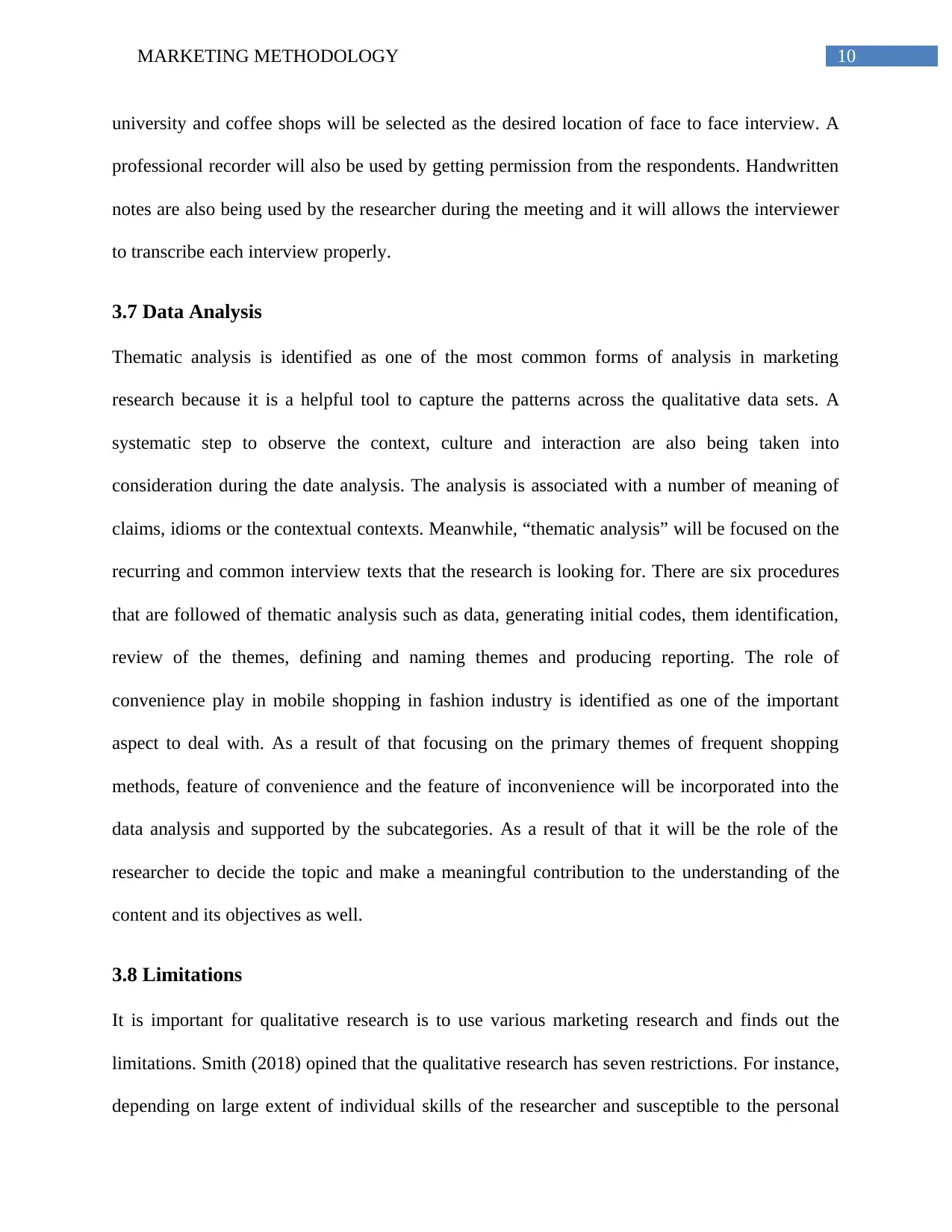
10MARKETING METHODOLOGY
university and coffee shops will be selected as the desired location of face to face interview. A
professional recorder will also be used by getting permission from the respondents. Handwritten
notes are also being used by the researcher during the meeting and it will allows the interviewer
to transcribe each interview properly.
3.7 Data Analysis
Thematic analysis is identified as one of the most common forms of analysis in marketing
research because it is a helpful tool to capture the patterns across the qualitative data sets. A
systematic step to observe the context, culture and interaction are also being taken into
consideration during the date analysis. The analysis is associated with a number of meaning of
claims, idioms or the contextual contexts. Meanwhile, “thematic analysis” will be focused on the
recurring and common interview texts that the research is looking for. There are six procedures
that are followed of thematic analysis such as data, generating initial codes, them identification,
review of the themes, defining and naming themes and producing reporting. The role of
convenience play in mobile shopping in fashion industry is identified as one of the important
aspect to deal with. As a result of that focusing on the primary themes of frequent shopping
methods, feature of convenience and the feature of inconvenience will be incorporated into the
data analysis and supported by the subcategories. As a result of that it will be the role of the
researcher to decide the topic and make a meaningful contribution to the understanding of the
content and its objectives as well.
3.8 Limitations
It is important for qualitative research is to use various marketing research and finds out the
limitations. Smith (2018) opined that the qualitative research has seven restrictions. For instance,
depending on large extent of individual skills of the researcher and susceptible to the personal
university and coffee shops will be selected as the desired location of face to face interview. A
professional recorder will also be used by getting permission from the respondents. Handwritten
notes are also being used by the researcher during the meeting and it will allows the interviewer
to transcribe each interview properly.
3.7 Data Analysis
Thematic analysis is identified as one of the most common forms of analysis in marketing
research because it is a helpful tool to capture the patterns across the qualitative data sets. A
systematic step to observe the context, culture and interaction are also being taken into
consideration during the date analysis. The analysis is associated with a number of meaning of
claims, idioms or the contextual contexts. Meanwhile, “thematic analysis” will be focused on the
recurring and common interview texts that the research is looking for. There are six procedures
that are followed of thematic analysis such as data, generating initial codes, them identification,
review of the themes, defining and naming themes and producing reporting. The role of
convenience play in mobile shopping in fashion industry is identified as one of the important
aspect to deal with. As a result of that focusing on the primary themes of frequent shopping
methods, feature of convenience and the feature of inconvenience will be incorporated into the
data analysis and supported by the subcategories. As a result of that it will be the role of the
researcher to decide the topic and make a meaningful contribution to the understanding of the
content and its objectives as well.
3.8 Limitations
It is important for qualitative research is to use various marketing research and finds out the
limitations. Smith (2018) opined that the qualitative research has seven restrictions. For instance,
depending on large extent of individual skills of the researcher and susceptible to the personal
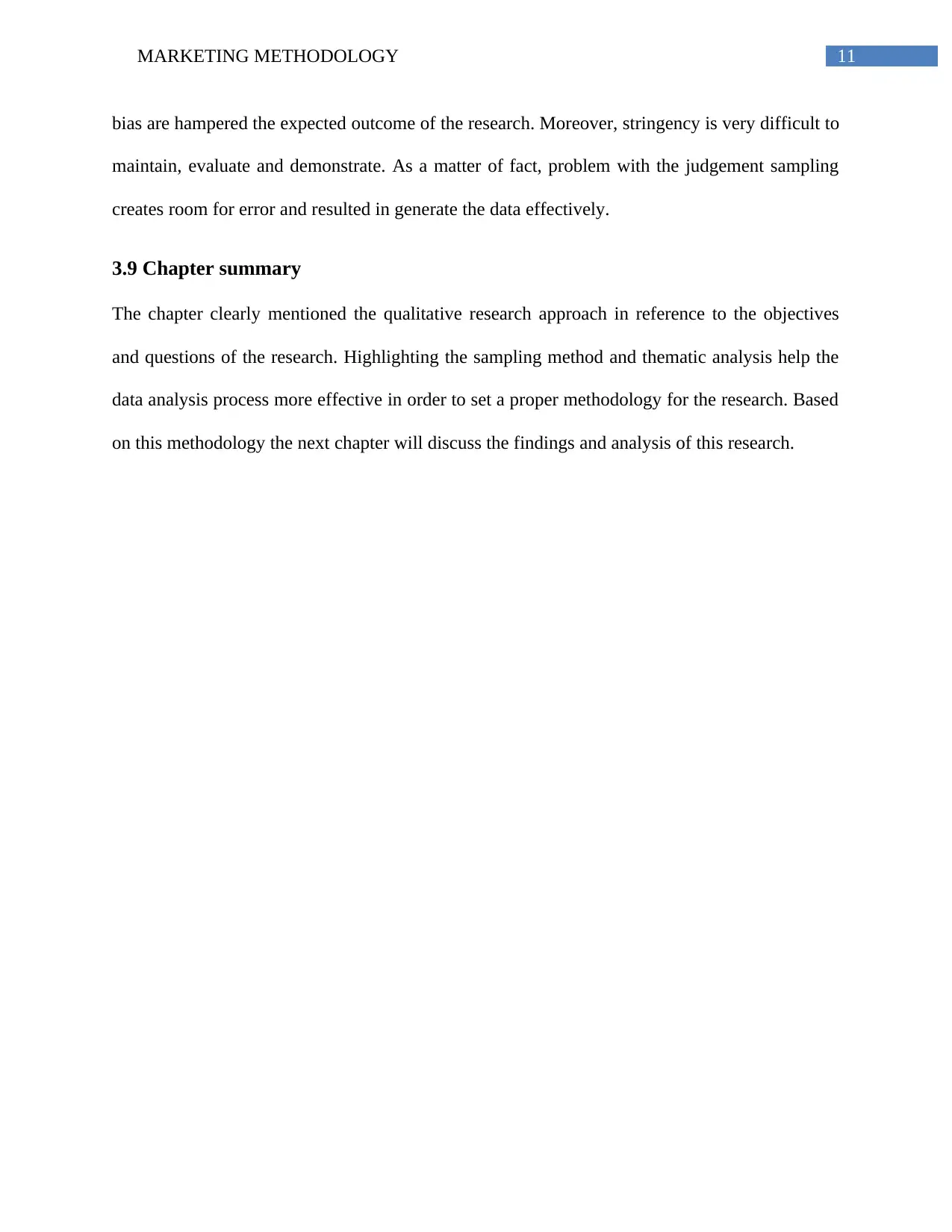
11MARKETING METHODOLOGY
bias are hampered the expected outcome of the research. Moreover, stringency is very difficult to
maintain, evaluate and demonstrate. As a matter of fact, problem with the judgement sampling
creates room for error and resulted in generate the data effectively.
3.9 Chapter summary
The chapter clearly mentioned the qualitative research approach in reference to the objectives
and questions of the research. Highlighting the sampling method and thematic analysis help the
data analysis process more effective in order to set a proper methodology for the research. Based
on this methodology the next chapter will discuss the findings and analysis of this research.
bias are hampered the expected outcome of the research. Moreover, stringency is very difficult to
maintain, evaluate and demonstrate. As a matter of fact, problem with the judgement sampling
creates room for error and resulted in generate the data effectively.
3.9 Chapter summary
The chapter clearly mentioned the qualitative research approach in reference to the objectives
and questions of the research. Highlighting the sampling method and thematic analysis help the
data analysis process more effective in order to set a proper methodology for the research. Based
on this methodology the next chapter will discuss the findings and analysis of this research.
⊘ This is a preview!⊘
Do you want full access?
Subscribe today to unlock all pages.

Trusted by 1+ million students worldwide
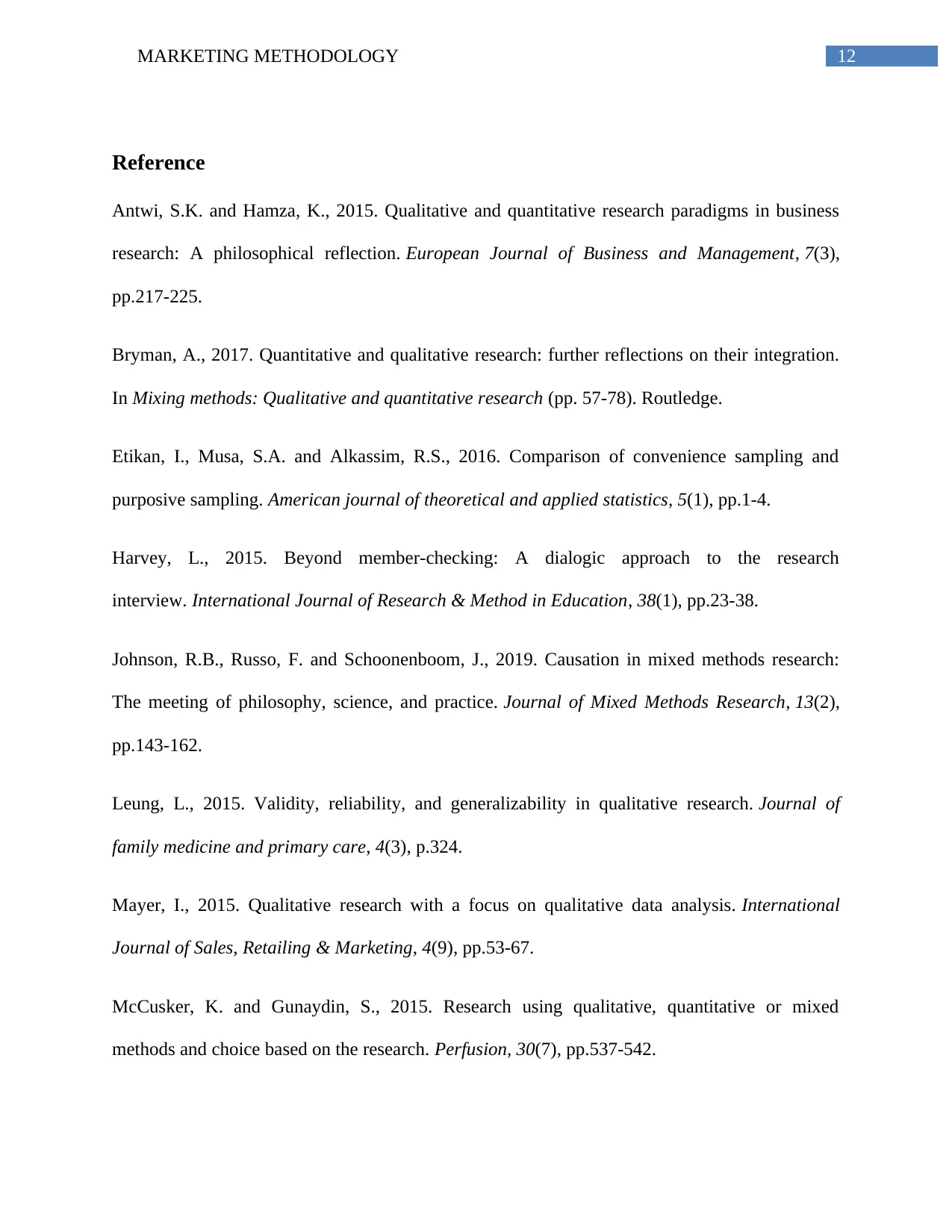
12MARKETING METHODOLOGY
Reference
Antwi, S.K. and Hamza, K., 2015. Qualitative and quantitative research paradigms in business
research: A philosophical reflection. European Journal of Business and Management, 7(3),
pp.217-225.
Bryman, A., 2017. Quantitative and qualitative research: further reflections on their integration.
In Mixing methods: Qualitative and quantitative research (pp. 57-78). Routledge.
Etikan, I., Musa, S.A. and Alkassim, R.S., 2016. Comparison of convenience sampling and
purposive sampling. American journal of theoretical and applied statistics, 5(1), pp.1-4.
Harvey, L., 2015. Beyond member-checking: A dialogic approach to the research
interview. International Journal of Research & Method in Education, 38(1), pp.23-38.
Johnson, R.B., Russo, F. and Schoonenboom, J., 2019. Causation in mixed methods research:
The meeting of philosophy, science, and practice. Journal of Mixed Methods Research, 13(2),
pp.143-162.
Leung, L., 2015. Validity, reliability, and generalizability in qualitative research. Journal of
family medicine and primary care, 4(3), p.324.
Mayer, I., 2015. Qualitative research with a focus on qualitative data analysis. International
Journal of Sales, Retailing & Marketing, 4(9), pp.53-67.
McCusker, K. and Gunaydin, S., 2015. Research using qualitative, quantitative or mixed
methods and choice based on the research. Perfusion, 30(7), pp.537-542.
Reference
Antwi, S.K. and Hamza, K., 2015. Qualitative and quantitative research paradigms in business
research: A philosophical reflection. European Journal of Business and Management, 7(3),
pp.217-225.
Bryman, A., 2017. Quantitative and qualitative research: further reflections on their integration.
In Mixing methods: Qualitative and quantitative research (pp. 57-78). Routledge.
Etikan, I., Musa, S.A. and Alkassim, R.S., 2016. Comparison of convenience sampling and
purposive sampling. American journal of theoretical and applied statistics, 5(1), pp.1-4.
Harvey, L., 2015. Beyond member-checking: A dialogic approach to the research
interview. International Journal of Research & Method in Education, 38(1), pp.23-38.
Johnson, R.B., Russo, F. and Schoonenboom, J., 2019. Causation in mixed methods research:
The meeting of philosophy, science, and practice. Journal of Mixed Methods Research, 13(2),
pp.143-162.
Leung, L., 2015. Validity, reliability, and generalizability in qualitative research. Journal of
family medicine and primary care, 4(3), p.324.
Mayer, I., 2015. Qualitative research with a focus on qualitative data analysis. International
Journal of Sales, Retailing & Marketing, 4(9), pp.53-67.
McCusker, K. and Gunaydin, S., 2015. Research using qualitative, quantitative or mixed
methods and choice based on the research. Perfusion, 30(7), pp.537-542.
Paraphrase This Document
Need a fresh take? Get an instant paraphrase of this document with our AI Paraphraser
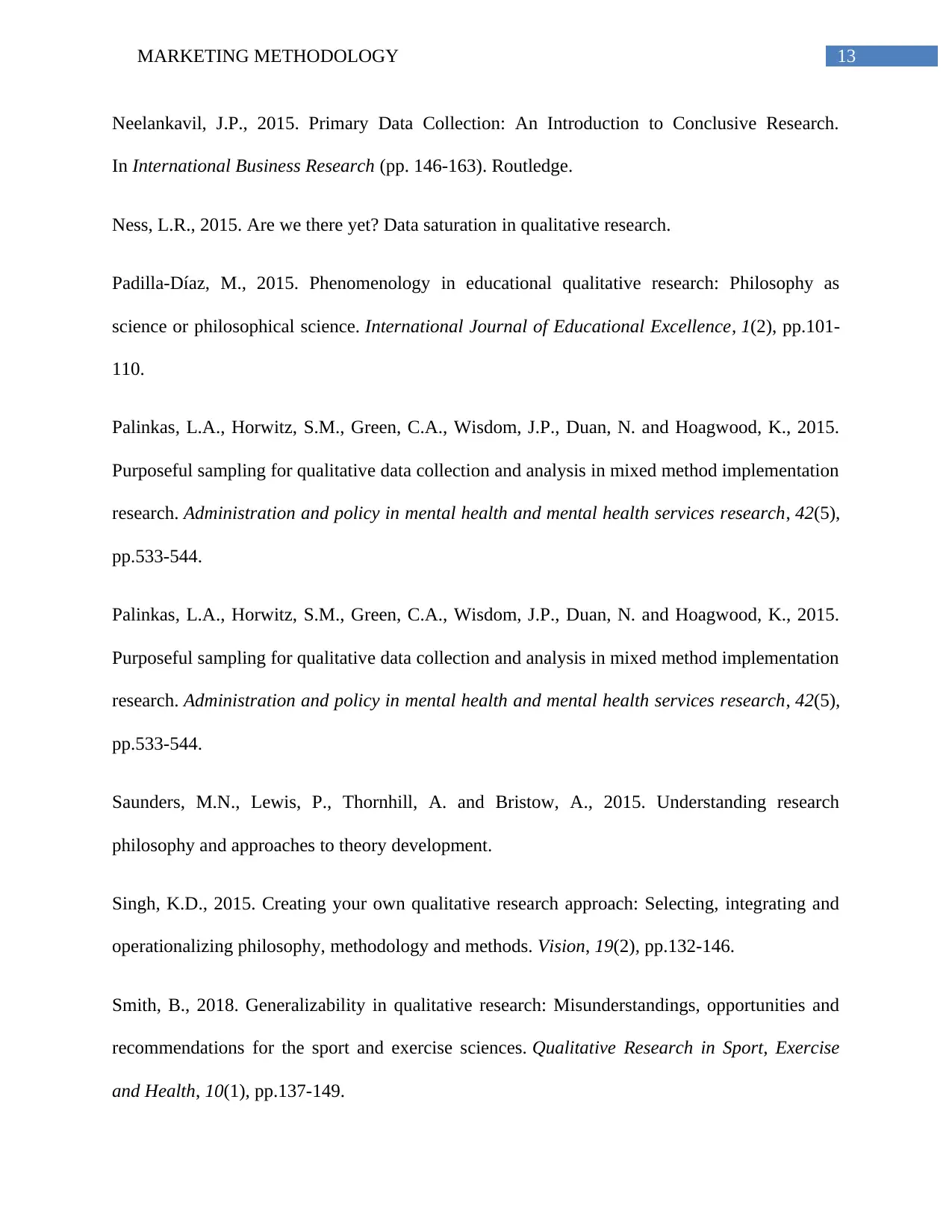
13MARKETING METHODOLOGY
Neelankavil, J.P., 2015. Primary Data Collection: An Introduction to Conclusive Research.
In International Business Research (pp. 146-163). Routledge.
Ness, L.R., 2015. Are we there yet? Data saturation in qualitative research.
Padilla-Díaz, M., 2015. Phenomenology in educational qualitative research: Philosophy as
science or philosophical science. International Journal of Educational Excellence, 1(2), pp.101-
110.
Palinkas, L.A., Horwitz, S.M., Green, C.A., Wisdom, J.P., Duan, N. and Hoagwood, K., 2015.
Purposeful sampling for qualitative data collection and analysis in mixed method implementation
research. Administration and policy in mental health and mental health services research, 42(5),
pp.533-544.
Palinkas, L.A., Horwitz, S.M., Green, C.A., Wisdom, J.P., Duan, N. and Hoagwood, K., 2015.
Purposeful sampling for qualitative data collection and analysis in mixed method implementation
research. Administration and policy in mental health and mental health services research, 42(5),
pp.533-544.
Saunders, M.N., Lewis, P., Thornhill, A. and Bristow, A., 2015. Understanding research
philosophy and approaches to theory development.
Singh, K.D., 2015. Creating your own qualitative research approach: Selecting, integrating and
operationalizing philosophy, methodology and methods. Vision, 19(2), pp.132-146.
Smith, B., 2018. Generalizability in qualitative research: Misunderstandings, opportunities and
recommendations for the sport and exercise sciences. Qualitative Research in Sport, Exercise
and Health, 10(1), pp.137-149.
Neelankavil, J.P., 2015. Primary Data Collection: An Introduction to Conclusive Research.
In International Business Research (pp. 146-163). Routledge.
Ness, L.R., 2015. Are we there yet? Data saturation in qualitative research.
Padilla-Díaz, M., 2015. Phenomenology in educational qualitative research: Philosophy as
science or philosophical science. International Journal of Educational Excellence, 1(2), pp.101-
110.
Palinkas, L.A., Horwitz, S.M., Green, C.A., Wisdom, J.P., Duan, N. and Hoagwood, K., 2015.
Purposeful sampling for qualitative data collection and analysis in mixed method implementation
research. Administration and policy in mental health and mental health services research, 42(5),
pp.533-544.
Palinkas, L.A., Horwitz, S.M., Green, C.A., Wisdom, J.P., Duan, N. and Hoagwood, K., 2015.
Purposeful sampling for qualitative data collection and analysis in mixed method implementation
research. Administration and policy in mental health and mental health services research, 42(5),
pp.533-544.
Saunders, M.N., Lewis, P., Thornhill, A. and Bristow, A., 2015. Understanding research
philosophy and approaches to theory development.
Singh, K.D., 2015. Creating your own qualitative research approach: Selecting, integrating and
operationalizing philosophy, methodology and methods. Vision, 19(2), pp.132-146.
Smith, B., 2018. Generalizability in qualitative research: Misunderstandings, opportunities and
recommendations for the sport and exercise sciences. Qualitative Research in Sport, Exercise
and Health, 10(1), pp.137-149.
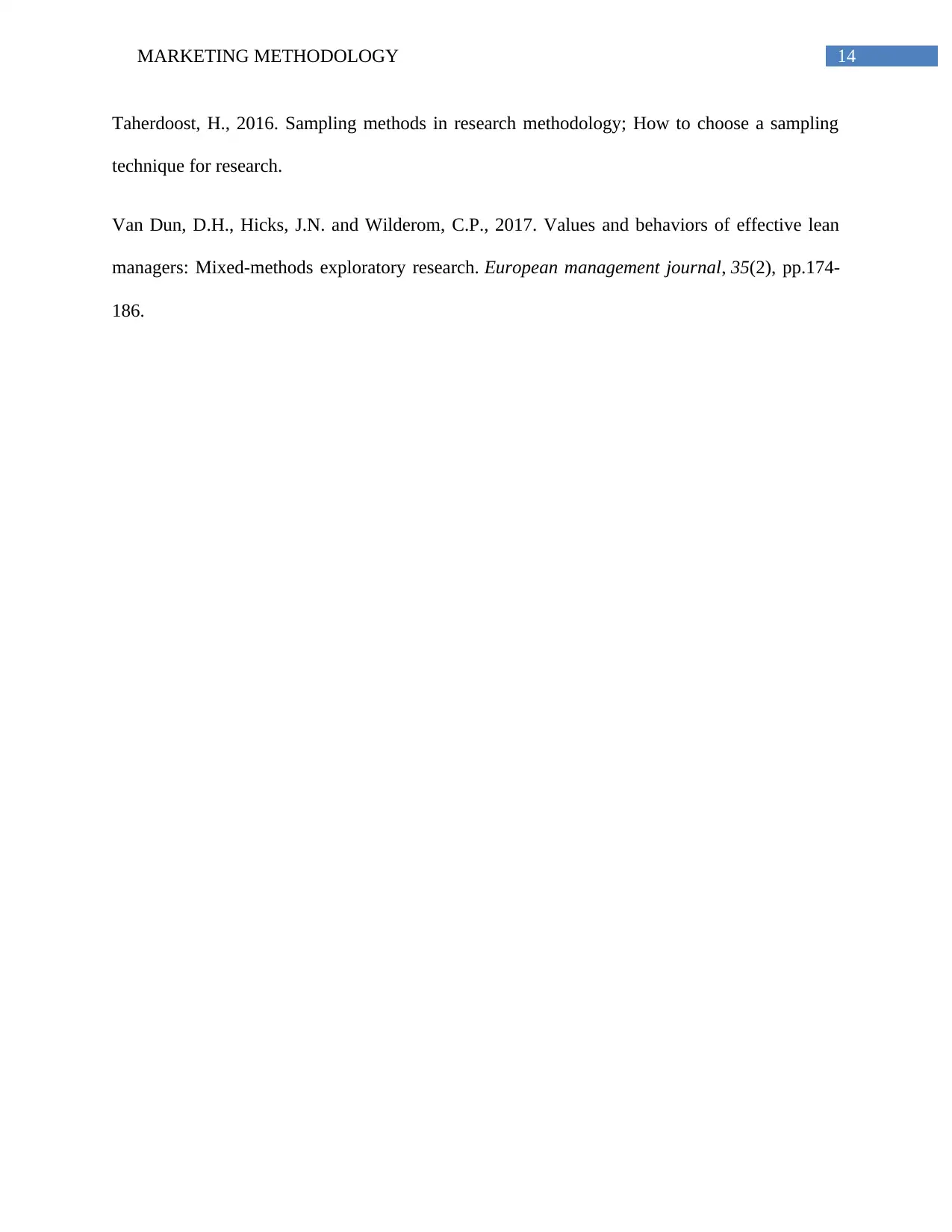
14MARKETING METHODOLOGY
Taherdoost, H., 2016. Sampling methods in research methodology; How to choose a sampling
technique for research.
Van Dun, D.H., Hicks, J.N. and Wilderom, C.P., 2017. Values and behaviors of effective lean
managers: Mixed-methods exploratory research. European management journal, 35(2), pp.174-
186.
Taherdoost, H., 2016. Sampling methods in research methodology; How to choose a sampling
technique for research.
Van Dun, D.H., Hicks, J.N. and Wilderom, C.P., 2017. Values and behaviors of effective lean
managers: Mixed-methods exploratory research. European management journal, 35(2), pp.174-
186.
⊘ This is a preview!⊘
Do you want full access?
Subscribe today to unlock all pages.

Trusted by 1+ million students worldwide
1 out of 15
Related Documents
Your All-in-One AI-Powered Toolkit for Academic Success.
+13062052269
info@desklib.com
Available 24*7 on WhatsApp / Email
![[object Object]](/_next/static/media/star-bottom.7253800d.svg)
Unlock your academic potential
© 2024 | Zucol Services PVT LTD | All rights reserved.





